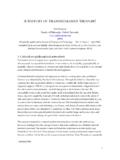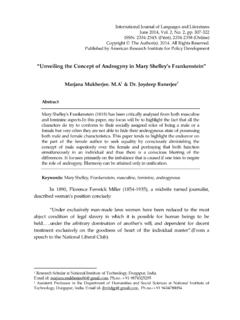Transcription of Ozymandias - ASAMnet e.V.
1 Ozymandias by Percy Bysshe Shelley 1 2 3 4 5 6 7 8 I MET a traveller from an antique land, Who said: Two vast and trunkless legs of stone Stand in the desert. Near them on the sand, Half sunk, a shatter'd visage lies, whose frown And wrinkled lip and sneer of cold command Tell that its sculptor well those passions read Which yet survive, stamp'd on these lifeless things, The hand that mock'd them and the heart that fed; 9 10 11 12 13 14 And on the pedestal these words appear: My name is Ozymandias , king of kings: Look on my works, ye Mighty, and despair! Nothing beside remains. Round the decay Of that colossal wreck, boundless and bare, The lone and level sands stretch far away.
2 1. logical structure * Ozymandias , or Ramese II, was pharaoh of Egypt in the thirteenth century 1. The poem, as an Italian sonnet, can be divided into two parts: the first eight lines (octave) and the next six lines (sestet). If the octave part describes the fragments of a sculpture the traveler sees on an ancient ruin, the sestet goes further to record the words on the pedestal and then describe the surrounding emptiness. How are the words on the pedestal in contrast to both the octave and the last three lines (triplet) of the poem? In other words, what does Ozymandias want to achieve, as opposed to what is left behind him? The feet of the colossus of Rameses II on which Shelley's poem Ozymandias is based.
3 From Art, Space and the City p. 68. 2. Irony From the last question, we can see the most obvious kind of opposition (between what Ozymandias said and what is left behind him). This opposition has the effect of dramatic irony. What other sets of oppositions or conflicts can we see in the poem? Are they ironic? 3. Structure of narration The poem contains a story (told by Ozymandias ) within a story (told by the traveler) within a story (told by) the speaker of the poem). In the core of this multiple story, the Ozymandias we know is only a sculpture and the words on it. What does this, as well as the narrative structure, say about history and art? Application & Wild Association Different Art Forms and Life: Consider "The Dance"(by William Carlos Williams), "Musee des Beaux Arts," (by W.
4 H. Auden), "Ode on a Grecian Urn" and " Ozymandias ". How do these poems (as verbal art) deal with plastic arts? "Musee des Beaux Arts," " Ozymandias " and "Ode on a Grecian Urn" relate art to human world in different ways. How are their focuses and attitudes different? And how do YOU relate the literary works we have read to your life? 30 Jan. 07 < #shelley> This poem expresses its moral through a vivid and ironic picture; a shattered stone statue with only the legs and head remaining, standing in the desert. The face is proud and arrogant, however, all that surrounds the statue is a desert. This poem is written to express to us that possessions don t mean immortality - ironically, the king who seemed to think that his kingdom would remain under his statue s haughty gaze forever teaches us this through his epitaph.
5 Look on my works, ye Mighty, and despair! becomes good advice, though in an opposite meaning than the king intended, for it comes to mean that despite all the power and might one acquires in the course of one s life, material possessions will not last forever. In the end, the King s works are nothing, and the lines inscribed upon his statue are a sermon to those who read it. 30 Jan. 07 < > Percy Bysshe Shelley (1792-1822), one of the major contributors to English Romantic poetry wrote Ozymandias ; probably his most famous short poem, Ozymandias was published in 1818. The second-hand narration attempts to resurrect the once powerful king's might while the exotic setting of Egypt and desert sands helps illuminate the struggle between artist and subject.
6 Shelley often attracted criticism and controversy for his outspoken challenges to oppression, religion, and convention as in his political poem The Masque of Anarchy (1819), a critical look at the Peterloo massacre; Rise like Lions after slumber In unvanquishable number, Shake your chains to earth like dew Which in sleep had fallen on you- Ye are many they are few. Written in terza rima Ode To The West Wind (1820) is another of Shelley s calls for revolution and change. Other longer visionary works by Shelley include The Revolt of Islam and Prometheus Unbound (1820). He also expressed profound tenderness and sympathy for humankind such as in The Magnetic Lady to Her Patient and deep love in poems dedicated to Mary; O Mary dear, that you were here With your brown eyes bright and clear.
7 And your sweet voice, like a bird Singing love to its lone mate In the ivy bower disconsolate; Voice the sweetest ever heard! And your brow Than the .. sky Of this azure Italy. Mary dear, come to me soon, I am not well whilst thou art far; As sunset to the sphered moon, As twilight to the western star, Thou, beloved, art to me. O Mary dear, that you were here; The Castle echo whispers 'Here!' To Mary (1818) Shelley found friendship with fellow poets John Keats and Lord George Gordon Byron as well as paving the way for future esteemed poets Robert Browning, Dante Gabriel Rossetti, Algernon Charles Swinburne, Lord Alfred Tennyson, and William Butler Yeats. His life and works are studied still and his influence lives on in the 21st century.
8 Percy Bysshe Shelley was born on 4 August 1792 in Horsham, Sussex, England. He was the eldest of the seven children of Elizabeth Pilfold and Timothy Shelley, a country squire who would become baronet in 1815 on the death of his father. Young Percy attended Sion House Academy before entering Eton College in 1804. These six years in a conventional institution were not happy ones for Shelley, where his idealism and controversial philosophies were developing. At this time he wrote such works as the Gothic Zastrozzi (1810) and The Necessity of Atheism (1811); If the knowledge of a God is the most necessary, why is it not the most evident and the clearest? After Shelley s expulsion from Oxford College for expressing his atheistic views, and now estranged from his father, he eloped with sixteen-year old Harriet Westbrook (1795-1816) to Scotland.
9 They married on 28 August 1811 and would have two children, daughter Ianthe born in 1813 ( ) and son Charles born in 1814. Inviting college friend Thomas Hogg into their household, Shelley attempted an open marriage to the consternation of Harriet, which led to the demise of their marriage. For the next three years Shelley made several trips to London to the bookshop and home of atheist journalist William Godwin, the father of Mary Wollstonecraft Godwin (1797-1851). Influenced by William Wordsworth, he continued to write poetry including Queen Mab: A Philosophical Poem (1813) and participated in various political reform activities. He was also studying the writings of Godwin s and embracing his radical philosophy.
10 Percy Shelley s forays to the Godwins also resulted in his acquaintance with his daughter Mary, who almost immediately proved to be his intellectual equal. The poets fondness for each other soon grew and in 1814, Shelley eloped a second time with Mary and her stepsister Claire in tow, settling in Switzerland. This action drew the disapproval of both their fathers, and they struggled to support themselves. The Shelleys were spending much time with Lord George Gordon Byron who also led a controversial life of romantic entanglements and political activity. Shelley was passionate about life and very generous to his friends, which often caused him financial hardship. They passed their days sailing on the lake and telling each other ghost stories.


